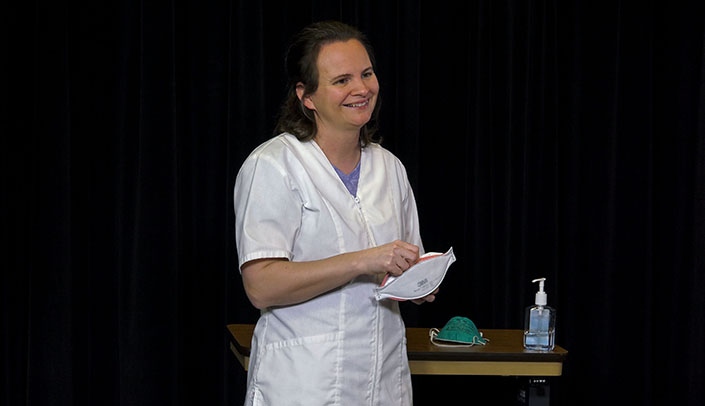No one knew in August of 2018 just how critically important it would be for health care professionals to learn to properly use N95 respirators.
“It was less common then to see health care workers wearing them in their daily tasks, now you don’t see a respiratory tech, nurse or doctor without one,” said Elizabeth Beam, Ph.D., assistant professor in the UNMC College of Nursing and assistant director of research for the Nebraska Biocontainment Unit.
For nine months, from August 2018 until April 2019, Dr. Beam conducted a study among health care professionals at Nebraska Medical Center and Bellevue Medical Center on how well they don and doff N95 respirators and what educational measures could be utilized to improve performance.
Her research is published in the American Journal of Infection Control.
Each participant was asked to don and doff an N95 respirator as they normally would while being recorded. Then they either watched a four-minute training video from the Centers for Disease Control and Prevention (CDC) on the proper way to don and doff a respirator or watched the CDC video and then scored themselves donning and doffing using a checklist to evaluate how they did. They repeated the video recorded donning and doffing the day of the training and one month later.
“Just asking them to watch the CDC video alone provided a little bit of improvement, but we saw a significant difference in those who had to complete the checklist,” said Jocelyn Herstein, Ph.D., the study coordinator.
When Dr. Beam re-evaluated the studt participants 30 days later, participants who completed all three tasks — watching the CDC video, filming themselves donning and doffing, and evaluating their own performance via the checklist — proved to have the greatest staying power.
“The checklist touched on many of the same points as the CDC video, but what seemed to make the difference was having the participants film themselves so they could see how well they did or didn’t do and that really improved their overall performance and stayed with them one month later,” Dr. Beam said.
With the onset of the pandemic it became even more apparent to Dr. Beam that following proper protocol for donning and doffing a respirator would become a key factor in protecting health care professionals on the front lines.
“We wear masks a lot to cover our mouth and nose, but with respirators you want to breathe through them and not around them so it is so important to make sure you have a good seal when you wear one,” she said.
That means making sure the straps are where they need to be, the mask is molded around the face and the mask fits properly so the provider is not exposed to whatever is in the room.
“For me personally, heath care worker safety is a big component to health care workers spending their careers at the bedside,” Dr. Beam said. “The safer each person can feel in the work they do the more likely they are to maintaining their role and continuing their career.”

Great work Beth! The College of Nursing is lucky to have you! Beth Culross
Blessed to be her Mom. Her outreach capabilities amaze. Thanks, Beth. L, Mom
Beth,
You make me proud to be your Uncle.
Keep up the good work !
Beth you amaze me! So proud of you!
Great job, Beth!